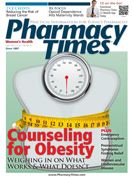Publication
Article
Pharmacy Times
Women's Health Watch
Better Fitness May Lengthen Survival in Breast Cancer Patients
Cardiopulmonary function is significantly impaired in breast cancer patients at all points along the survivorship continuum, but higher cardiopulmonary function is associated with significantly longer survival times, according to the results of a study published online on May 21, 2012, in the Journal of Clinical Oncology.
Researchers from the Duke University Medical Center set out to evaluate how cardiopulmonary function was affected by breast cancer treatment before, during, and after adjuvant therapy for nonmetastatic disease, as well as during therapy for metastatic disease. To do so, they measured peak oxygen consumption (VO2peak ) at rest and during exercise in 248 women at various stages of treatment.
Results indicated that fitness levels for women with breast cancer in all stages of treatment were worse than for healthy, sedentary women of comparable age. In fact, one-third of the cancer patients in the study had cardiopulmonary function scores below the level normally required to perform everyday tasks independently.
The researchers also noted that cancer patients with higher cardiopulmonary function had median survival times approximately 20 months longer than those with poor fitness scores. The team at Duke is currently conducting studies to further examine the effects of exercise training on cancer patient survival rates.
Aspirin Use Linked to Reduced Melanoma Risk
Regular aspirin use in women is associated with a reduction in the risk of malignant melanoma, and increasing the duration of use to 5 years or longer offers even greater protection against the progression of the disease, according to an analysis of the Women’s Health Initiative (WHI) presented at the 2012 Society for Investigative Dermatology Annual Meeting.
The researchers extracted data about the nonsteroidal anti-inflammatory drugs (NSAIDs) taken by 59,806 WHI participants at least twice a week during the 2 weeks before enrollment in the initiative. At baseline, 25% of the women reported using aspirin, 15% reported using other NSAIDs, and 59% reported using neither.
Over nearly 12 years of followup, there were 548 new melanoma diagnoses in the participants: 115 in aspirin users, 89 in users of other NSAIDs, and 344 in nonusers of NSAIDs. Overall, the risk of melanoma in aspirin users was 21% lower than in nonusers. The risk was even lower for those who regularly used aspirin for 5 years or longer.
Laboratory studies have shown that NSAIDs such as aspirin inhibit the action of the pro-inflammatory enzyme COX-2. Overexpression of COX-2 is thought to be associated with increased cancer risk, and the converted byproducts of COX-2 can also stimulate cancer progression.
Fever During Pregnancy More Than Doubles Risk of Autism
Mothers who reported having an untreated fever during pregnancy were more than twice as likely to have a child with autism or a developmental delay than mothers who did not, according to the results of a study published online May 23, 2012, in the Journal of Autism and Developmental Disorders.
The Childhood Autism Risk from Genetics and the Environment (CHARGE) study, carried out at the University of California Davis MIND Institute, included 538 children with autism, 163 with developmental delays, and 421 with typical development. The children’s mothers reported whether they had the flu during gestation and whether they took medications such as antipyretics to treat their symptoms.
Of the 191 mothers who reported having had a fever during their pregnancy, 76 reported treating it with antipyretics. For children of mothers who took these anti-fever medications, the risk of autism decreased to the level associated with mothers reporting no fever.
Previous studies have suggested a link between infectious diseases during gestation and a heightened risk of having a child with neurodevelopmental disorders. Fever, much like infection, can produce an inflammatory healing response characterized by the release of cytokines. These cytokines can pass through the placenta into the fetus during pregnancy, potentially altering levels of neurotransmitters and affecting fetal brain development.







